






 |
|
High-Accuracy Recognition of
Muscle Activation Patterns Using a Hierarchical Classifier
by
Luis Rivera and Nicholas
Smith
Introduction
Systems based on Surface Electromyography
(sEMG) signals require some form of machine learning algorithm for recognition
and classification of specific patterns of muscle activity. These algorithms
vary in terms of the number of signals, feature selection, and the
classification algorithm used. In our previous work, a technique for recognizing
muscle patterns using a single sEMG signal, called Guided Underdetermined Source
Signal Separation (GUSSS), was introduced. This technique relied on a very small
number of features to achieve good classification accuracies for a small number
of gestures. In this work, an enhanced version called Hierarchical GUSSS (HiGUSSS)
was developed to allow for the classification of a large number of hand gestures
while preserving a high classification accuracy.
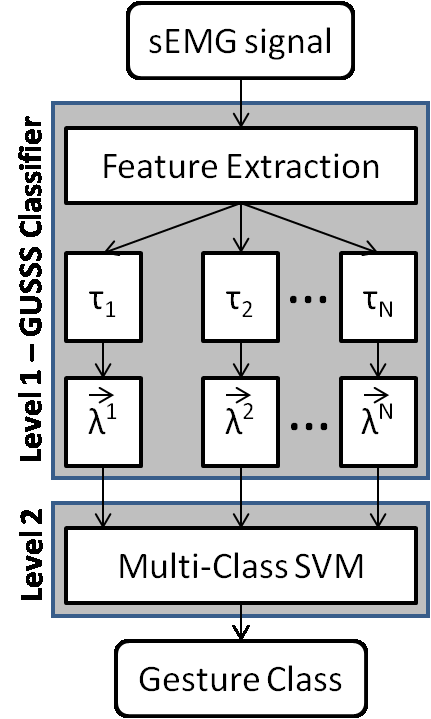
Figure 1. Proposed framework.
Proposed Method: This work enhances
the original classification approach from [3] and [4]. A
hierarchical classifier is implemented and additional features
are extracted from the sEMG signals. The proposed framework for
the method is illustrated in Figure 1 and consists of a
two-level hierarchical classifier: 1) GUSSS-based classifiers;
and 2) a Multi-Class SVM. The first level in the hierarchy
involves a number of GUSSS-based classifiers, which function as
confidence generators, inputing feature vectors extracted from
the raw sEMG signal and outputting N confidence vectors. The
elements of the vectors indicate the confidence that a sEMG
signal contains a particular signature in a tuple (a group with
an arbitrary number of signatures). All of the obtained
confidence vectors are concatenated into a second feature
vector, which is then input to the classifier at the second
level of the hierarchy. The output of the second level
classifier is the final class assigned to the observed sEMG
signal.
Experiments and Results: The goals of
the experiments performed in this work were the following: 1)
contrast with [3] for the same number of gestures (4) and with
more gestures (5); 2) compare HiGUSSS with non-hierarchical
methods; and 3) investigate how the accuracy varies as the
number of gestures increases.
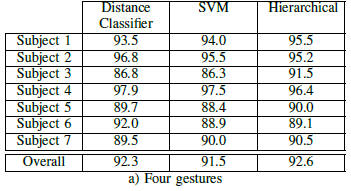
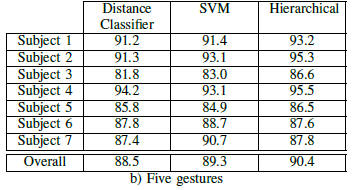
Tables 1 and 2. Classification
accuracies for 7 test subjects. The values are average percent
ages over a 10-fold cross validation (105 signals per gesture).
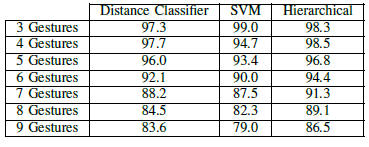
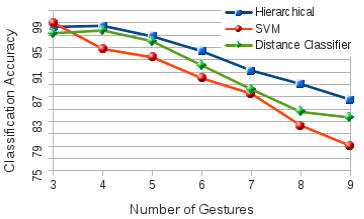
Table 3 and Figure 2.
Classification accuracy vs. number of gestures used.
Conclusion: The results obtained in
this work demonstrate the discriminant power of HiGUSSS. Its
better performance compared to the other classifiers is because
the hierarchical method employs tuples of gestures instead of
comparing each gesture against every other gesture. This is more
noticeable as the number of gestures increases.
References
-
L. A. Rivera, N. R. Smith,
and G. N. DeSouza, “High-Accuracy Recognition of Muscle Activation
Patterns Using a Hierarchical Classifier”, 5th IEEE RAS &
EMBS International
Conference on Biomedical Robotics and Biomechatronics, São
Paulo, Brazil, August 12 –
15, 2014.
-
L. A. Rivera and G. N. DeSouza, “Haptic
and Gesture-Based Assistive Technologies for People with Motor
Disabilities”, book chapter in Assistive Technologies and
Computer Access for Motor Disabilities, IGI Global, 2013.
-
L. A. Rivera and G. N. DeSouza, “A
Power Wheelchair Controlled using Hand Gestures, a
Single sEMG Sensor, and Guided Under-determined
Source Signal Separation”,
4th IEEE RAS & EMBS International Conference on Biomedical
Robotics and Biomechatronics, Rome, Italy, June
24 – 27, 2012.
See this paper on IEEE.org
-
L. A. Rivera and G. N. DeSouza, “Recognizing
Hand Movements from a Single sEMG Sensor using Guided
Under-determined Source Signal Separation”, 12th
IEEE International Conference on Rehabilitation Robotics, ETH
Zurich, Switzerland, June 29 – July 1, 2011.
See this paper on IEEE.org
|

